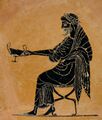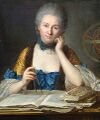Template:Selected anniversaries/December 17: Difference between revisions
No edit summary |
No edit summary |
||
| (2 intermediate revisions by the same user not shown) | |||
| Line 30: | Line 30: | ||
File:Marius Sophus Lie.jpg|link=Marius Sophus Lie (nonfiction)|1842: Mathematician and academic [[Marius Sophus Lie (nonfiction)|Marius Sophus Lie]] born. He will largely create the theory of continuous symmetry and apply it to the study of geometry and differential equations. | File:Marius Sophus Lie.jpg|link=Marius Sophus Lie (nonfiction)|1842: Mathematician and academic [[Marius Sophus Lie (nonfiction)|Marius Sophus Lie]] born. He will largely create the theory of continuous symmetry and apply it to the study of geometry and differential equations. | ||
||1853: Pierre Paul Émile Roux born ... physician, bacteriologist, and immunologist ... one of the closest collaborators of Louis Pasteur (1822–1895), a co-founder of the Pasteur Institute, and responsible for the institute's production of the anti-diphtheria serum, the first effective therapy for this disease. Pic. | |||
||1861: Arthur Edwin Kennelly born ... electrical engineer. Pic. | ||1861: Arthur Edwin Kennelly born ... electrical engineer. Pic. | ||
| Line 56: | Line 56: | ||
||1912: Fritz Klingenberg born ... German officer in the Waffen-SS who served with the SS Division Das Reich and was a commander of the SS Division Götz von Berlichingen. He was best known for his role in the capture of the Yugoslavian capital, Belgrade with just 6 men, for which he was awarded the Knight's Cross of the Iron Cross. Pic. | ||1912: Fritz Klingenberg born ... German officer in the Waffen-SS who served with the SS Division Das Reich and was a commander of the SS Division Götz von Berlichingen. He was best known for his role in the capture of the Yugoslavian capital, Belgrade with just 6 men, for which he was awarded the Knight's Cross of the Iron Cross. Pic. | ||
||1916: Martin Arthur Pomerantz born ... physicist who served as Director of the Bartol Research Institute and who had been a leader in developing Antarctic astronomy. Pic search | ||1916: Martin Arthur Pomerantz born ... physicist who served as Director of the Bartol Research Institute and who had been a leader in developing Antarctic astronomy. Pic search. | ||
||1920: Kenneth E. Iverson born ... computer scientist, developed the APL programming language. Pic. | ||1920: Kenneth E. Iverson born ... computer scientist, developed the APL programming language. Pic. | ||
| Line 74: | Line 74: | ||
||1961: Niterói circus fire: Fire breaks out during a performance by the Gran Circus Norte-Americano in the city of Niterói, Rio de Janeiro, Brazil, killing more than 500. | ||1961: Niterói circus fire: Fire breaks out during a performance by the Gran Circus Norte-Americano in the city of Niterói, Rio de Janeiro, Brazil, killing more than 500. | ||
||1964: Victor Francis Hess dies ... physicist and academic, Nobel Prize laureate, discovered cosmic rays. Pic. | |||
||1964: Victor Francis Hess dies ... physicist and academic, Nobel Prize laureate. | |||
||1964: Jurjen Ferdinand Koksma dies ... mathematician who specialized in analytic number theory. Pic: book cover. | ||1964: Jurjen Ferdinand Koksma dies ... mathematician who specialized in analytic number theory. Pic: book cover. | ||
| Line 90: | Line 88: | ||
||2014: Dieter Grau dies ... scientist and engineer. Peenemunde. Pic. | ||2014: Dieter Grau dies ... scientist and engineer. Peenemunde. Pic. | ||
||2015: Osamu Hayaishi dies ... biochemist and academic. Pic search | ||2015: Osamu Hayaishi dies ... biochemist and academic. Pic search. | ||
</gallery> | </gallery> | ||
Latest revision as of 17:20, 7 February 2022
498 BC: Dionysus gives speech which anticipates the coming of Saturnalia.
497 BC: The first Saturnalia festival celebrated in ancient Rome.
1706: Mathematician and physicist Émilie du Châtelet born. She will translate and comment upon on Isaac Newton's Principia Mathematica.
1835: Felice Casorati born. Casorati will contribute the Casorati–Weierstrass theorem in complex analysis.
1842: Mathematician and academic Marius Sophus Lie born. He will largely create the theory of continuous symmetry and apply it to the study of geometry and differential equations.
1900: Mathematician and academic Mary Cartwright born. She will do pioneering work in what will later be called chaos theory.
1907: Lord Kelvin dies. He did much to unify the emerging discipline of physics in its modern form.
1938: Physicist Otto Hahn discovers the nuclear fission of the heavy element uranium, the scientific and technological basis of nuclear energy.







